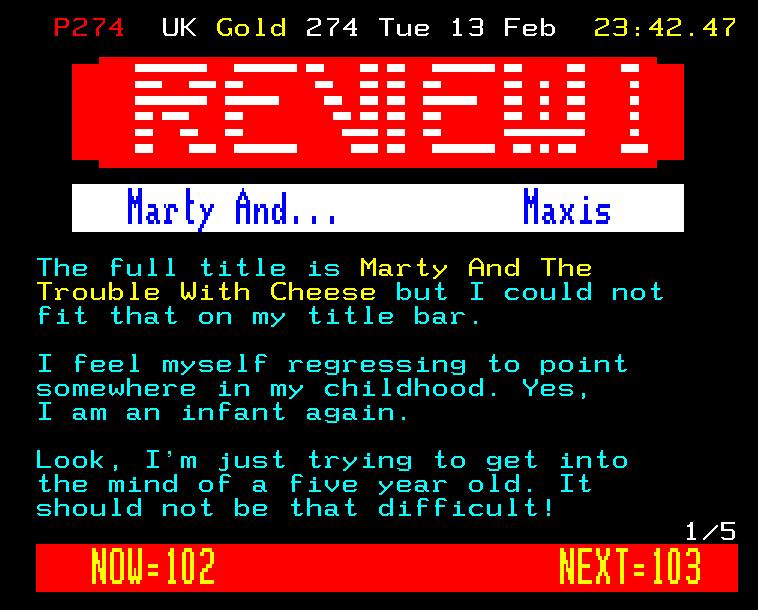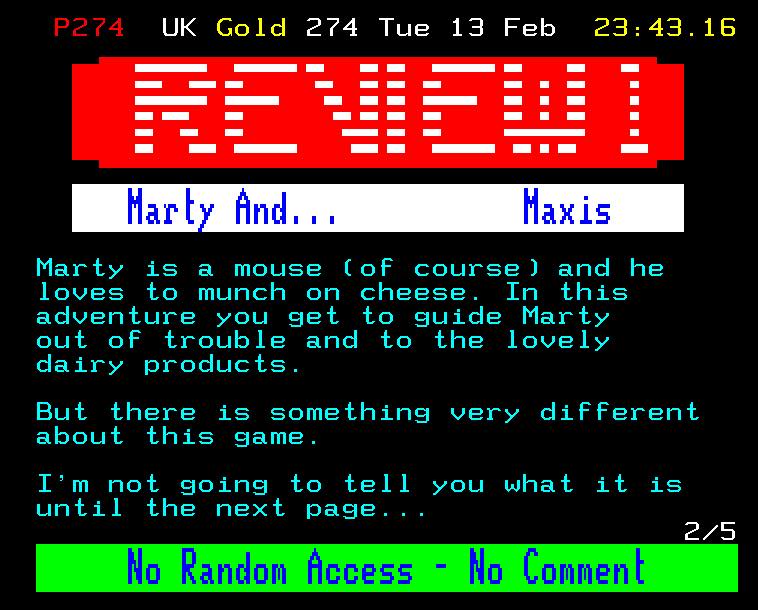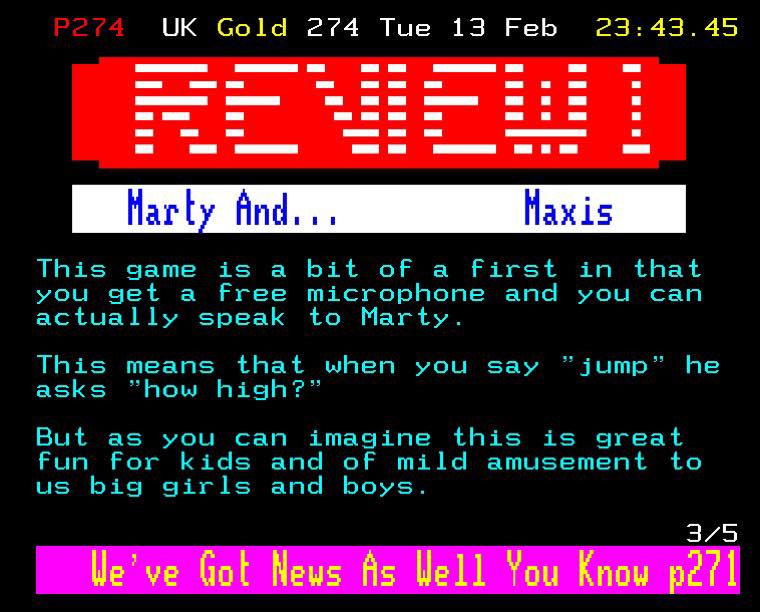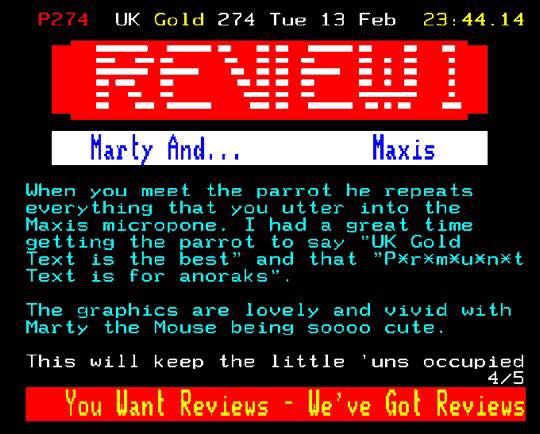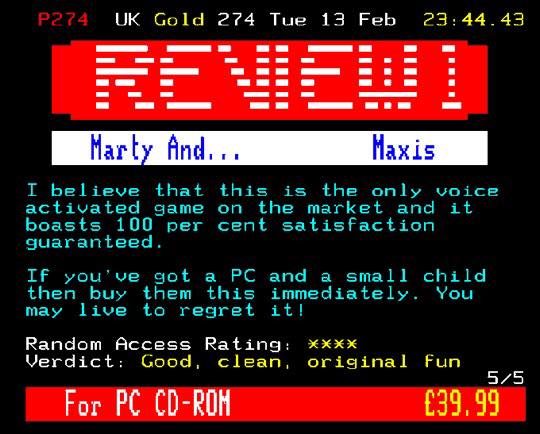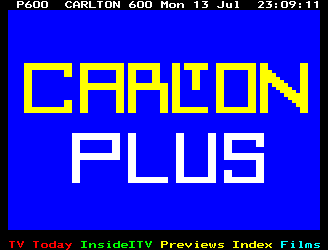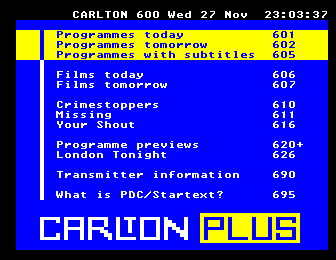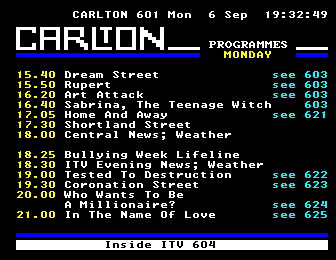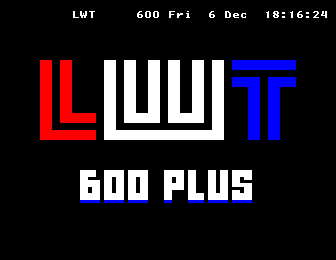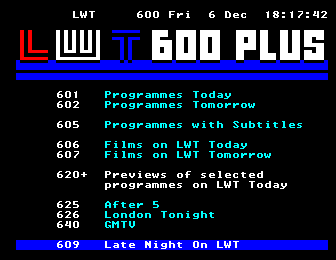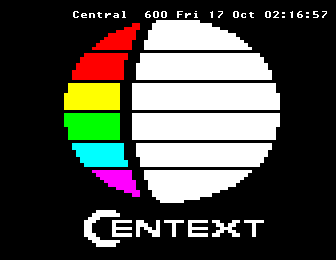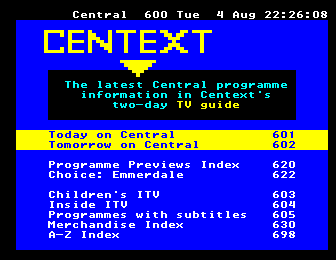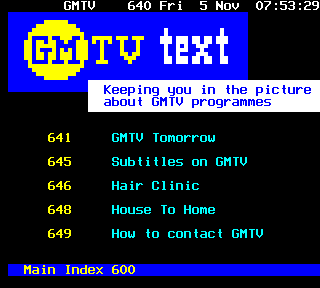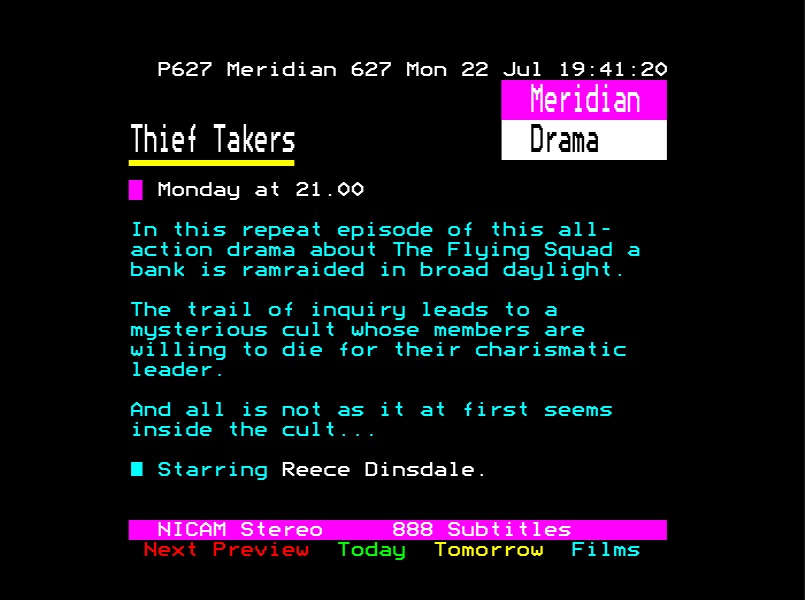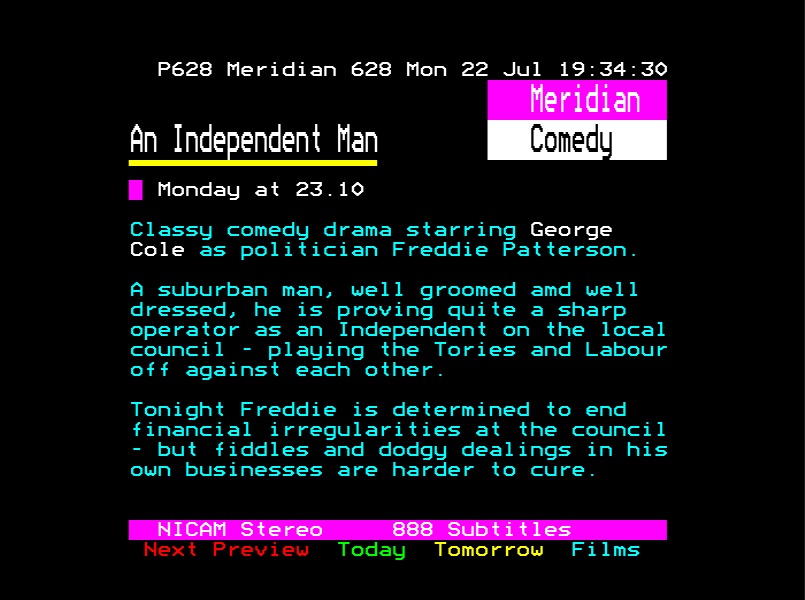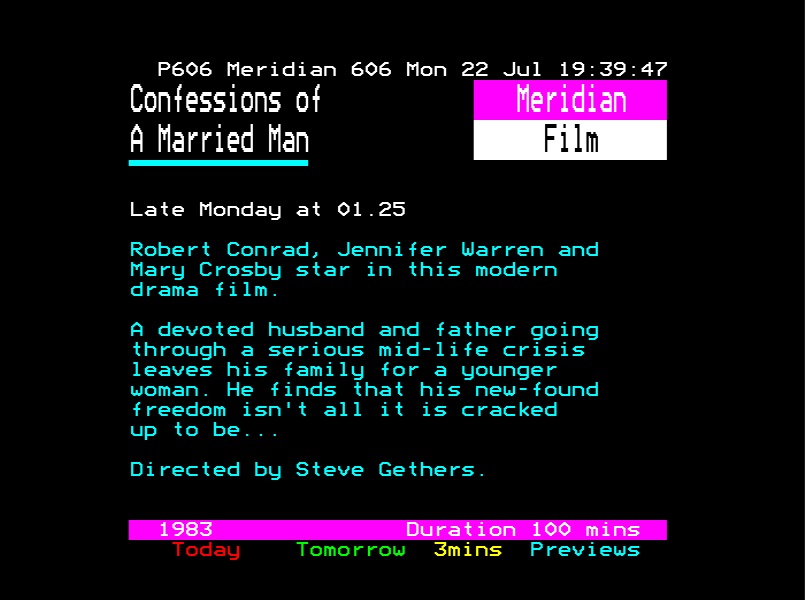For those who do not follow my story, many years ago I actually held down a paying job and worked in the heady and mysterious world of teletext. Explaining teletext now is a bit like explaining the whaling industry, both are a redundant throw back to a bygone age and have been replaced by better and more enlightened ways.
But for those of you who aren’t getting misty-eyed for “the good old days” remembering a slow, archaic and often corrupted format of media distribution, will need an explanation. Teletext was an early form of electronic publishing that sat inside the broadcast television signal of the terrestrial channels broadcast in the UK. With a teletext enabled TV set, by the push of a button, you could access all manner of information: from news to weather to TV listings to quizzes and other items to distract you from your impending mortality.
I worked for a company called Intelfax from 1995 to 2000 who provided a number of teletext services on the independent TV channels and I was responsible for maintaining the Carlton, Central, LWT and GMTV ancillary pages that existed between the 600-699 slots. It was an intense experience coming up with accurate listings and getting This Morning recipes to air in less than thirty minutes. The recipes would be sent just before broadcast via fax machine and we’d have to re-write and edit for style and space and have them on air before Richard and Judy uttered the words “and you can see this recipe on ITV text page 654”.
I enjoyed the work because it kept my active mind busy. I wore out three industrial cherry style keyboards while I was there, which is an indicator of just how much typing was involved and why I have a stupendously fast touch-typing speed – though I’ve slowed down a bit with age. While I was at the company, I read the manual to the hardware and figured out how to send pages across all the regional services with some code and single-handedly automise most of our work. I often used to crash the servers and get myself in bother with the management, but I felt I was making a difference and for a while, I was. Then when the spectre of digital TV reared its head, I tried to tell them that the company need to branch out into web publishing and hosting, but my suggestions weren’t taken on board.
Instead, I was told that I needed to learn MHEG code and that I was to programme demo digital TV services that the company would shlep around to the TV companies in order to prove their worth. At this time, no-one knew what the digital future was going to look like and I was slowly sending myself mad doing this coding until one day I told the boss that I didn’t think I was up to the job and he said that if I didn’t work harder, the door was that way. That was a sobering moment and as a young sprout, I took that without question. Nowadays, he’d have had a chair thrown at him…
The company was moving in a direction I wasn’t happy with and at the turn of the millennium, I realised the days were numbered and I needed to move on, not before working on Millennium Day and earning so much money for a single sitting, that I still can’t believe it to this day. Though the site of riding in the cab through London on Millennium Day will always stay with me as it look almost post-apocalyptic but there where empty champagne bottles in the gutter.
My memories there are mixed. I enjoyed hooking up a VHS to the TV system and hosting Friday afternoon fun where I’d play The Simpsons episodes and whatever else people requested to get our small team through the week. I enjoyed working weekend shifts and quiet stillness of being in those offices at Lower Marsh and latterly Westminster Bridge Road. I enjoyed the pace of the work and the many lost evenings in the pub. I probably drank far too much back then and there were many times when I woke up at home without realising how I’d got there. I remember dealing with the clueless public and how one time an irate pensioner who was upset that her TV reception was failing due to a dodgy aerial called me “Tony Blair’s white nigger” (I’ll have to get that put on a T-shirt).
I can’t say I made any friends at that place because once I was gone, I was gone. Nobody ever kept in contact and those days are purely for nostalgia. The only thing I miss was the workload (I like to be kept busy) and the money they threw at me.
So why this post? Well every year there’s a #nationalteletexday and there’s a community of people who seem obsessed by this defunct form of media. It’s like an electronic version of the wax cylinder appreciation society. I have no idea why people are so obsessive about it, but they are, and if it gets them through the night, so what?
But I didn’t keep any of the work I did there, whereas I’ve often kept cuttings of my proper published magazine work. I didn’t keep one scrap of it (though in my archive I do have a complete backup of the original Intelfax website that I worked on, while I was there). There are some pages out there on other websites which I will include below, but some of the stuff I feel a little pang of nostalgia it seemingly lost. I don’t see teletext as being worth saving, it was a relic even back then with web publishing pushing to the fore, and there was a real sense that everything we did was utterly disposable because it was update often on a daily basis. You didn’t have time to even think of saving something.
For example, for a time between 1995-98, I used to produce a weekly computer games section on UK Gold teletext, which featured news and reviews and what-not. I had a fairly young audience, so I kept everything bright and breezy and as I got loads of review material in from the games publishers, I organised weekly competitions that used to get around 150 entries and ended up being the biggest thing in the office (in terms of public response). It was called “Random Access” and I was particularly proud of it because it was the only thing I did there that was actually mine, that belonged to me, that was my total creation. I remember once when I was off sick for a week and didn’t manage to update the section, I received a letter from a concerned father asking if the section was coming back because his son was upset it was missing and it was his favourite thing. It’s those moments when you get humbled.
Until yesterday, I had not a single trace of it or reference but thanks to some sad teletext bastard, a few pages came my way, a fragment of what was, a digital ghost of the past. And now they are here… What goes around comes around. The universe flows back to me…
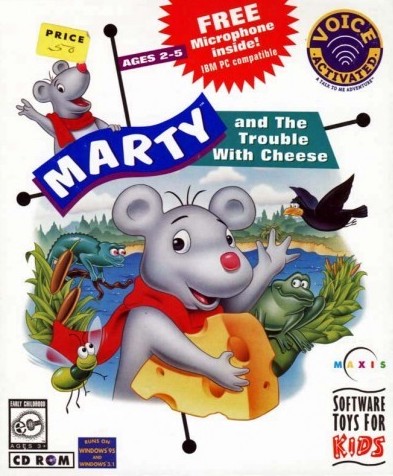
My other claim to fame while working at Intelfax was being part of the team that created the now legendary late-night TV show format “ITV Nightscreen” – though if you look at the Wikipedia page for that, the true originators of the format are not credited or mentioned. It was us ITV ancillary teletext folk that sat down and decided what was going to be featured and I think we even named it! But hey, I know the truth and now so do you. (I would love to mention my colleagues by name and credit them too, but in this age of data privacy I don’t think I can).
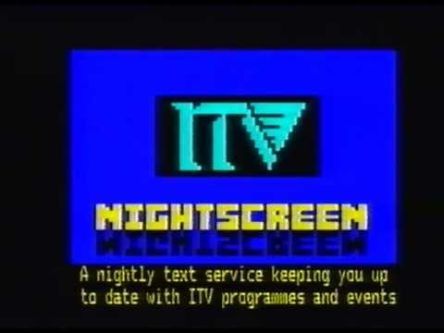
And here’s some video when moved over from it being teletext based to us using SCALA presentation software to add actual pictures and music to the whole shebang. High-tech, eh?
And here are some pages stolen from here & here that I designed and the content I wrote (I think) despite appearing on other services – that’s because we wrote the stuff and it got sent to all the various TV regions thanks to my grand unifying code.
And so now you know…
« Introducing DistroKid Teams – The Easy Way to Pay Your Collaborators 24-09-20 Metal Waves (Ways) »

